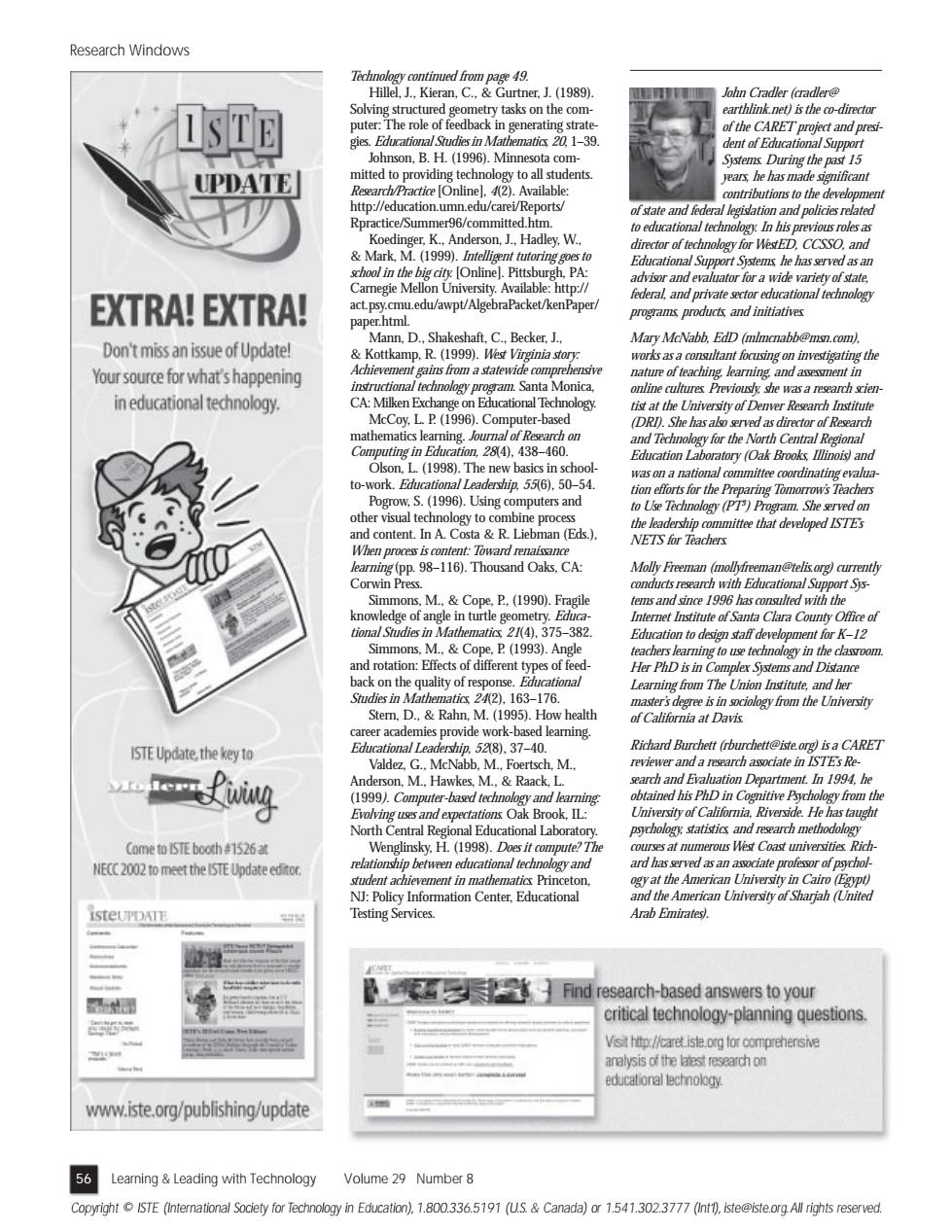正在加载图片...

Research Windows net,1.(1989 0s0 hnson.B.H.(6).Minnesota con UPDATE eh元 of state and fed 6防 sburgh.PA EXTRA!EXTRA! programs products and initiatives htm Mary menabh edd ( Don'tmissan issueof Update! Your source for what's happening ineducational. anta Monica ().Computer-based sity of Den e%n24s846 L()The puters and e p (16).Usingc NETS for 7 her CA with Educat M.&Co P (1990) Simmons,M.&Cope.P(1993).Angl PD血 nd D dies in ork-bas ISTE Update the key to CARET Raack, obtained his PhD in Cog g and expe k C0me的5Ebcha1526 sky.H (18).Doesit com steD四 Find research-based answers to your critical technology-planning questions. deatoraltectnoegy www.iste.org/publishing/update 3Leamning&Leading with Technology Volume9 Number850 Learning & Leading with Technology Volume 29 Number 8 Hillel, J., Kieran, C., & Gurtner, J. (1989). Solving structured geometry tasks on the computer: The role of feedback in generating strategies. Educational Studies in Mathematics, 20, 1–39. Johnson, B. H. (1996). Minnesota committed to providing technology to all students. Research/Practice [Online], 4(2). Available: http://education.umn.edu/carei/Reports/ Rpractice/Summer96/committed.htm. Koedinger, K., Anderson, J., Hadley, W., & Mark, M. (1999). Intelligent tutoring goes to school in the big city. [Online]. Pittsburgh, PA: Carnegie Mellon University. Available: http:// act.psy.cmu.edu/awpt/AlgebraPacket/kenPaper/ paper.html. Mann, D., Shakeshaft, C., Becker, J., & Kottkamp, R. (1999). West Virginia story: Achievement gains from a statewide comprehensive instructional technology program. Santa Monica, CA: Milken Exchange on Educational Technology. McCoy, L. P. (1996). Computer-based mathematics learning. Journal of Research on Computing in Education, 28(4), 438–460. Olson, L. (1998). The new basics in schoolto-work. Educational Leadership, 55(6), 50–54. Pogrow, S. (1996). Using computers and other visual technology to combine process and content. In A. Costa & R. Liebman (Eds.), When process is content: Toward renaissance learning (pp. 98–116). Thousand Oaks, CA: Corwin Press. Simmons, M., & Cope, P., (1990). Fragile knowledge of angle in turtle geometry. Educational Studies in Mathematics, 21(4), 375–382. Simmons, M., & Cope, P. (1993). Angle and rotation: Effects of different types of feedback on the quality of response. Educational Studies in Mathematics, 24(2), 163–176. Stern, D., & Rahn, M. (1995). How health career academies provide work-based learning. Educational Leadership, 52(8), 37–40. Valdez, G., McNabb, M., Foertsch, M., Anderson, M., Hawkes, M., & Raack, L. (1999). Computer-based technology and learning: Evolving uses and expectations. Oak Brook, IL: North Central Regional Educational Laboratory. Wenglinsky, H. (1998). Does it compute? The relationship between educational technology and student achievement in mathematics. Princeton, NJ: Policy Information Center, Educational Testing Services. Research Windows John Cradler (cradler@ earthlink.net) is the co-director of the CARET project and president of Educational Support Systems. During the past 15 years, he has made significant contributions to the development of state and federal legislation and policies related to educational technology. In his previous roles as director of technology for WestED, CCSSO, and Educational Support Systems, he has served as an advisor and evaluator for a wide variety of state, federal, and private sector educational technology programs, products, and initiatives. Mary McNabb, EdD (mlmcnabb@msn.com), works as a consultant focusing on investigating the nature of teaching, learning, and assessment in online cultures. Previously, she was a research scientist at the University of Denver Research Institute (DRI). She has also served as director of Research and Technology for the North Central Regional Education Laboratory (Oak Brooks, Illinois) and was on a national committee coordinating evaluation efforts for the Preparing Tomorrow’s Teachers to Use Technology (PT3 ) Program. She served on the leadership committee that developed ISTE’s NETS for Teachers. Molly Freeman (mollyfreeman@telis.org) currently conducts research with Educational Support Systems and since 1996 has consulted with the Internet Institute of Santa Clara County Office of Education to design staff development for K–12 teachers learning to use technology in the classroom. Her PhD is in Complex Systems and Distance Learning from The Union Institute, and her master’s degree is in sociology from the University of California at Davis. Richard Burchett (rburchett@iste.org) is a CARET reviewer and a research associate in ISTE’s Research and Evaluation Department. In 1994, he obtained his PhD in Cognitive Psychology from the University of California, Riverside. He has taught psychology, statistics, and research methodology courses at numerous West Coast universities. Richard has served as an associate professor of psychology at the American University in Cairo (Egypt) and the American University of Sharjah (United Arab Emirates). 56 Technology continued from page 49. Copyright © ISTE (International Society for Technology in Education), 1.800.336.5191 (U.S. & Canada) or 1.541.302.3777 (Int’l), iste@iste.org. All rights reserved